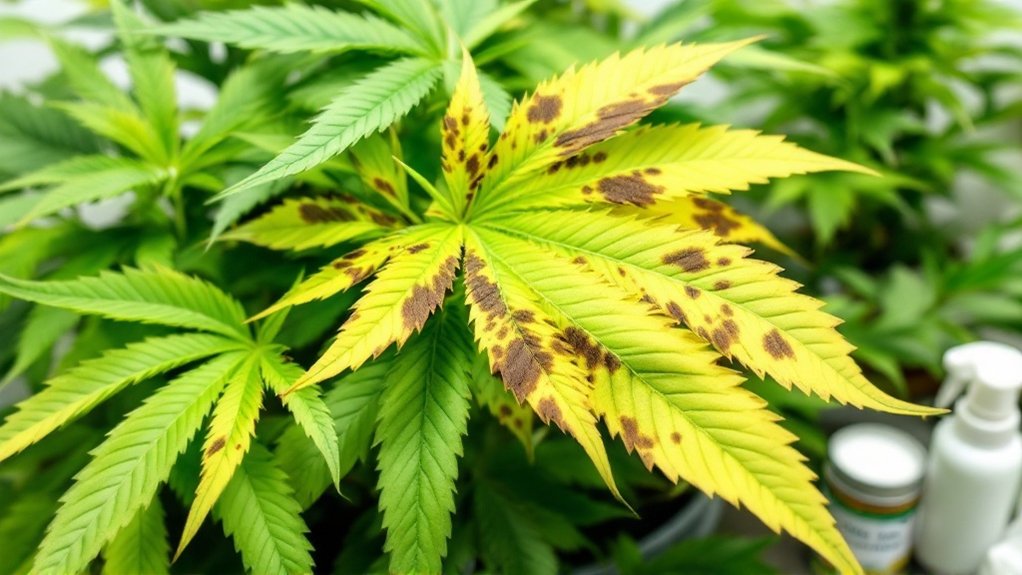Cannabis professionals operating in consulting, laboratory testing, and software services face unique liability exposures that traditional errors and omissions insurance may not adequately address. The complex regulatory landscape, evolving compliance requirements, and federal-state legal conflicts create substantial risk scenarios that can result in costly claims. Professional missteps, testing inaccuracies, or platform failures can trigger lawsuits worth millions, making specialized E&O coverage critical for business survival. However, securing appropriate protection requires understanding risks and coverage gaps that standard policies often overlook.
Understanding E&O Insurance Fundamentals in the Cannabis Industry
As the cannabis industry continues to evolve under complex regulatory frameworks, Errors and Omissions (E&O) insurance has become a critical form of professional liability coverage for businesses and individuals operating in this sector.
This specialized insurance protects against claims of negligence or mistakes in professional services, covering full-time employees, part-time staff, and sometimes independent contractors within cannabis enterprises.
E&O insurance proves essential for professional service firms, laboratories, consultants, and SaaS providers serving the cannabis market due to the industry’s intricate regulations and high potential for client disputes.
Policy features typically include coverage for defense costs, damages, settlements, disciplinary proceedings, and employee errors. E&O insurance addresses coverage gaps in ordinary product liability insurance policies that may not adequately protect cannabis businesses.
However, exclusions apply to intentional misconduct, criminal acts, and broad product liability claims, with specific terms varying by insurance provider.
High-Risk Professional Activities That Require E&O Protection
While the cannabis industry presents numerous opportunities for professional service providers, certain activities carry elevated risks that make Errors and Omissions insurance essential for protection against costly litigation and regulatory penalties.
Regulatory and compliance consulting ranks among the highest-risk activities, as rapidly changing cannabis laws create significant exposure to inadvertent compliance errors that can trigger license revocation or legal action.
Rapidly evolving cannabis regulations create substantial liability exposure for compliance consultants through inadvertent errors that may trigger severe legal consequences.
Enhanced due diligence requirements for anti-money laundering compliance demand precise client fund tracking, with failures resulting in substantial regulatory penalties.
Financial advisory services face serious risks from banking compliance missteps, which can lead to seized funds or criminal investigations. The cash-heavy nature of cannabis businesses creates additional complexity for financial advisors navigating banking restrictions and compliance requirements. Financial institutions must file suspicious activity reports when servicing marijuana-related businesses, creating additional liability concerns for advisors who fail to properly guide clients.
Product specification consultants encounter liability when flawed recommendations result in defective products or contamination incidents. Cannabis operations involve exposure to chemical hazards that can create additional liability for consultants providing safety guidance.
Cybersecurity professionals managing cannabis industry data face increasing exposure to breaches, ransomware attacks, and privacy violations that generate high-value insurance claims.
Laboratory Testing Liability and Compliance Errors
Among the most vulnerable professionals in the cannabis industry, laboratory testing specialists face unprecedented liability exposure due to widespread accuracy problems and inconsistent regulatory oversight.
Approximately 30% of cannabis testing labs in the US report false results, with these facilities testing 50-60% of all cannabis products. Labs frequently inflate THC potency data and overlook dangerous contaminants to attract clients and boost profits.
These compliance failures create serious legal risks. Testing laboratories face errors and omissions claims related to inaccurate reports that result in consumer harm or business losses.
Labs may encounter lawsuits from competitors for fraudulent reporting practices, while defective processes that miss contaminants can trigger class-action suits, product recalls, and regulatory penalties. The MCR Labs lawsuit against competitor labs demonstrates how testing disputes between industry players can escalate into costly legal battles over accountability and professional standards.
Recent data from Missouri reveals concerning disparities in Aspergillus testing failure rates, with one lab handling 82% of the state’s flower testing reporting significantly lower contamination detection rates than industry standards. Inadequate documentation and poor protocol adherence further increases legal exposure.
SaaS Platform Failures and Technology-Related Claims
Cannabis SaaS providers operate in a uniquely precarious technological landscape where platform failures can trigger cascading business disruptions and significant legal exposure.
Cloud outages can halt order processing entirely, causing immediate revenue loss for clients, particularly during high-volume periods like holidays. These failures expose sensitive customer data and financial records to potential breaches, with 81% of consumers disengaging from brands after security incidents.
Financial service disruptions compound these risks, as major platforms like Paychex and QuickBooks have terminated cannabis tech clients without warning. This creates payroll and cash flow crises that extend beyond the SaaS provider to affect their customers’ operations.
Manual process failures in automated systems can result in compliance violations, product recalls, and regulatory penalties, making thorough E&O coverage essential for cannabis technology vendors. The reliance on multiple disconnected systems further amplifies these risks, as businesses juggle various platforms for different functions, creating additional points of failure and data transfer vulnerabilities. Poor financial tracking within these systems can compromise regulatory compliance requirements, as cannabis businesses must maintain precise records for state audits and licensing renewals.
Essential Coverage Components for Cannabis Professionals
Given the complex regulatory environment and diverse operational risks facing cannabis businesses, professionals across the industry require extensive insurance portfolios that address both traditional business exposures and sector-specific challenges.
General liability coverage protects operations with physical locations against third-party bodily injury and property damage claims, including customer slips and falls.
Product liability becomes essential for cultivators, manufacturers, and retailers, covering legal defense costs, medical expenses, and recall expenses from contamination or defective products.
Professional liability insurance specifically protects consultants and labs from claims alleging negligence, errors, or faulty recommendations that cause client financial losses.
Property insurance safeguards physical assets from fire, theft, and natural disasters, while cyber liability coverage addresses data breaches and digital security risks increasingly prevalent across cannabis operations. Comprehensive financial documentation systems are crucial for proving losses and maintaining accurate audit trails in a highly scrutinized industry subject to unique tax regulations. Coverage must also satisfy retailer and distributor requirements that often mandate specific policy limits and terms. Auto liability coverage becomes particularly crucial for cannabis delivery businesses that face transportation risks when moving products between facilities or directly to consumers.
Policy Limits Specific to Cannabis Operations
While extensive coverage components form the foundation of cannabis insurance programs, the specific dollar amounts and limitations within these policies require careful consideration to match the unique risk profile of each operation.
Most cannabis businesses carry general liability policies with $1 million per-occurrence limits and $2 million aggregate limits, though state regulations like Massachusetts mandate minimum $1,000,000 coverage per loss occurrence.
High-risk operations often require elevated limits, with some insurers providing up to $4 million excess liability per layer.
Industry experts indicate many businesses need $5-10 million in coverage as exposure grows.
Sublimits frequently apply to product liability claims, theft, cyber incidents, and crop losses. Specialized insurers understand the cannabis industry’s unique liability exposures and can structure appropriate sublimit arrangements.
Testing labs face specific sublimits for laboratory errors, while consultants require E&O limits reflecting potential financial impact from guidance errors.
Workers compensation insurance requirements add another layer of mandatory coverage, with average costs reaching $374 monthly for businesses with employees to comply with state employment laws.
Market Availability and Surplus Lines Challenges
Despite the growing legitimacy of state-licensed cannabis operations, the insurance market for professional liability coverage remains severely constrained, with most policies available only through surplus lines carriers rather than traditional admitted insurers.
Fewer than 30 U.S. insurers currently offer any cannabis-related coverage, creating significant capacity limitations for businesses seeking protection.
Surplus lines carriers provide necessary flexibility in policy terms but typically charge higher premiums and impose stricter underwriting requirements. The hardening trend continues to impact the market with carriers implementing more restrictive terms and elevated pricing structures across all coverage lines.
These policies lack certain regulatory protections found in admitted markets, including guarantee funds and rate regulation. Federal restrictions on traditional banking relationships further complicate the insurance procurement process for cannabis businesses.
Cannabis companies must demonstrate strong compliance and risk management processes to qualify for coverage, while rigorous underwriting reviews examine experience, financial health, and claims history before approval.
Common Exclusions and Coverage Gaps to Address
Most E&O insurance policies for cannabis professionals contain numerous exclusions that create significant coverage gaps, leaving businesses vulnerable to substantial financial exposure even when they maintain seemingly thorough protection.
Health hazard exclusions commonly eliminate coverage for medical ailments resulting from cannabis use, often using sweeping language like “any form of disease” that can deny claims for acute incidents including allergic reactions or contamination events. The absence of an HH exclusion does not guarantee broader coverage, making careful evaluation of coverage forms essential in the cannabis insurance market.
Direct cannabis exclusions provide zero coverage for liabilities traced to cannabis business activities, while impairment exclusions target products altering mental state.
Product liability exclusions frequently omit coverage for adverse events linked to additives, supplements, or contamination in cannabis goods. Many policies exclude claims under the products-completed operations hazard, which can leave cannabis professionals exposed to liability for work performed after project completion.
Contractual liability exclusions may leave consultants, labs, and SaaS vendors uncovered for indemnification obligations in client agreements.
State Regulatory Variations and Federal Compliance Issues
How do cannabis professionals navigate the complex maze of state-by-state regulatory differences while managing federal compliance risks that threaten their E&O coverage? Each state establishes unique licensing and insurance requirements, creating significant challenges for multi-state operators.
Illinois demands $50,000 surety bonds for dispensaries and $2,000,000 financial responsibility for cultivators, while other states impose different thresholds and coverage mandates.
State-specific financial requirements create a patchwork of compliance burdens, with Illinois setting distinct bond and responsibility thresholds for cannabis operators.
E&O policy terms vary dramatically across state lines, with exclusions tied to licensing restrictions and industry-specific requirements. Cannabis remains federally illegal as a Schedule I substance, prompting some insurers to deny claims citing public policy grounds.
However, recent court decisions have inconsistently upheld coverage despite federal conflicts.
Service providers face particular scrutiny, as insurers often decline coverage for businesses perceived as “touching the plant” under federal guidelines, even indirectly. E&O insurance provides essential protection for businesses during mergers, acquisitions, and market expansions where regulatory complexities multiply across jurisdictions.
The approximately 800 credit unions and banks serving cannabis businesses must file Suspicious Activity Reports every 90 days, creating additional financial compliance burdens for insurance-seeking operators.
Cost Considerations and Premium Factors for Cannabis E&O
Cannabis professionals encounter premium costs that vary dramatically based on multiple interconnected factors, with annual E&O insurance expenses ranging from several hundred dollars for small consultancies to tens of thousands for large multi-state operations.
Coverage limits greatly impact pricing, with standard policies typically set at $1 million per occurrence and $2 million aggregate, alongside $5,000 deductibles for commercial packages.
Business size drives substantial cost variations, as larger enterprises with revenues approaching $10 million to $1 billion face higher premiums due to increased exposure.
Testing labs, SaaS vendors, and consultants each command unique premium profiles based on specific liability risks. Claims history heavily influences rates, while strong risk management practices can moderate increases. The quality of employee training directly impacts premium calculations since well-trained staff reduce the likelihood of operational errors that could trigger costly claims.
Geographic location, employee count, and specialized endorsements like cyber liability further affect final premium calculations. Making annual payments instead of monthly installments can reduce overall insurance costs by avoiding additional processing fees and charges.
This article provides general educational information about insurance and compliance requirements. Specific regulations vary by state and change frequently. Always consult with legal counsel and insurance experts for guidance on your specific situation and jurisdiction. For more information, check out our Guide to Cannabis Business Insurance.









